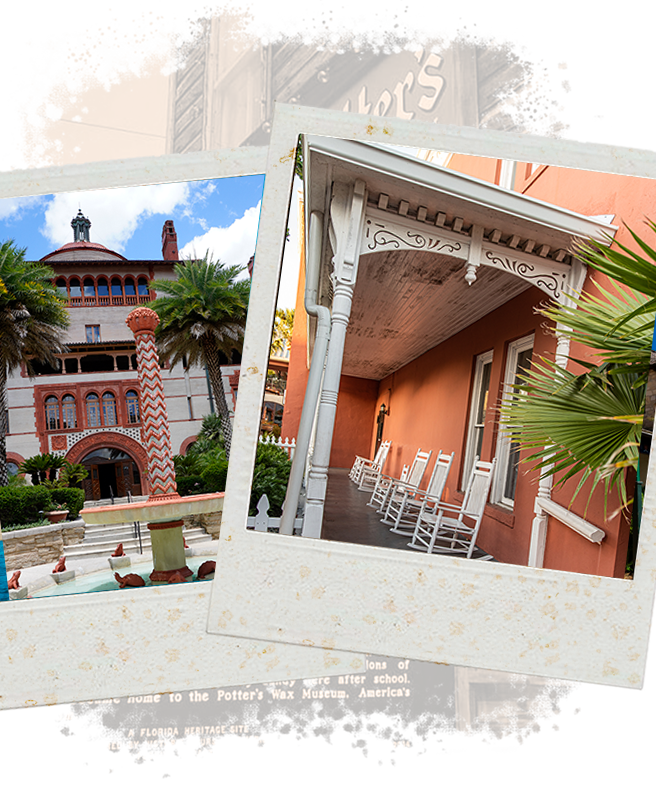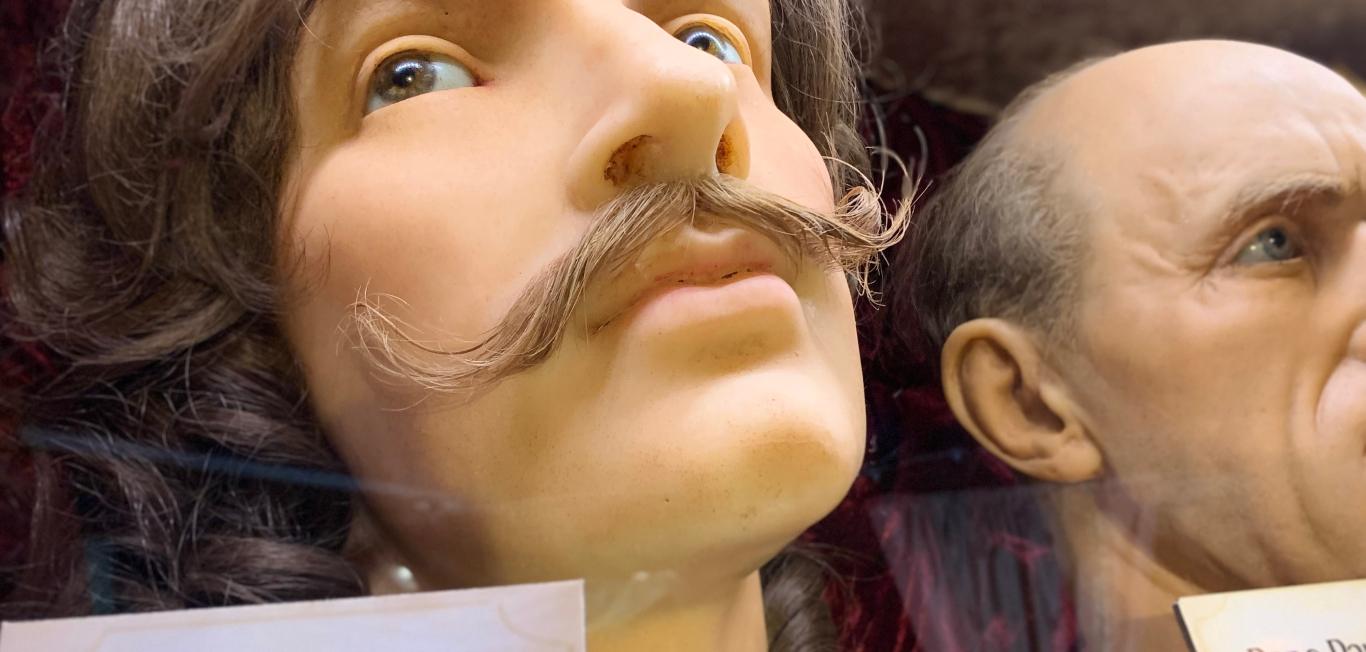A Guide to St. Augustine Landmarks for Your Vacation
Experience the enchanting charm of St. Augustine, the nation’s oldest city, where a wealth of history and lively culture come together in perfect harmony. From the awe-inspiring Castillo de San Marcos to the serene St. Augustine Lighthouse, this knowledgeable guide will lead you through the historical sites in St. Augustine, ensuring your vacation is an unforgettable journey.
Potter’s Wax Museum
Embark on an extraordinary journey through history at Potter’s Wax Museum. Prepare to step into the shoes of historic figures and celebrities as you come face-to-face with lifelike wax figures in this awe-inspiring museum. Founded in 1948, it is the first wax museum in the U.S., housing over 160 figures from history, entertainment, sports, and politics. Whether it’s coming eye-to-eye with Albert Einstein, or standing right next to Princess Diana, every visit promises a unique encounter. Don’t forget to snap a few photos with your favorite figures, a perfect keepsake from your St. Augustine vacation!

Lighthouse & Maritime Museum History
The St. Augustine Lighthouse & Maritime Museum stands as a sentinel to the maritime history of Florida. Erected between 1871 and 1874, this towering marvel replaced the original lighthouse established in 1824 by the territorial American government. For over a century, it served as a critical beacon guiding countless vessels safely to the St. Augustine port.
This St. Augustine historic site, with its enduring architectural grandeur, is a testament to St. Augustine’s long-standing maritime legacy and American history. It continues to draw crowds as one of St. Augustine’s essential landmarks, enchanting visitors with its captivating past and panoramic views. Its preservation as a museum allows guests a glimpse into the past and highlights the significance of lighthouses.
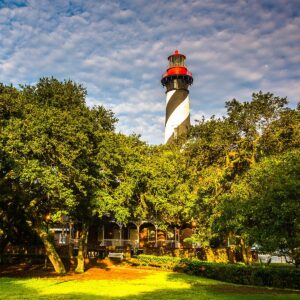
Things To Do at St. Augustine Lighthouse & Maritime Museum
Dark of the Moon Ghost Tour
Experience the Dark of the Moon Ghost Tour at the St. Augustine Lighthouse, where the slogan “All Ghosts, No Gimmicks!” comes to life. As the only ghost tour granting exclusive nighttime entry inside the tower, you’ll ascend the lighthouse in the dim glow of a provided glow stick. Throughout this spine-tingling 1.5- to 2-hour journey, your guide will recount the true tales of those who’ve shaped the lighthouse’s haunted history. This one-of-a-kind adventure is the sole experience offering after-dark access to the lighthouse grounds, creating an eerie atmosphere sure to thrill.
Ghost Tales
Step into the spectral past with the Ghost Tales Tour at the historic St. Augustine Lighthouse & Maritime Museum — a captivating adventure for the entire family. Over the course of an hour, your guide will take you on an enthralling excursion through the Lightkeepers’ House, its hallowed grounds, and the lighthouse’s base. There, amid this historic St. Augustine landmark, you’ll hear haunting stories intertwined with maritime history. Join this unique experience for an encounter with the ghosts of the lighthouse, designed to engage both the young and the young at heart.
The Sunset Moonrise Tour and Sunrise Tour
Enjoy breathtaking views of the sunset and full moonrise with champagne and hors d’oeuvres on top of the tower!
Lighthouse Illuminations
During the winter season’s festive celebration of Tides, Tidings, and Trees, the St. Augustine Lighthouse emerges in radiant splendor through the Lighthouse Illuminations event. Visitors are invited to embrace the holiday spirit as they witness the tower’s majestic glimmer, a beacon of yuletide warmth amid the crisp, ocean-fed breezes. This enchanting period offers an unparalleled museum experience, inviting guests to bask in the glow of illuminated history while creating lasting holiday memories.
The Maritime Archaeology and Education Center
Witness archaeologists in action at the working archaeology lab and explore fascinating artifacts from shipwrecks off Florida’s coast. Immerse yourself in the maritime history of the area, including the captivating St. Augustine historic sites. Discover more about maritime archaeology and education at this captivating center.
History of the Castillo de San Marcos National Monument
The Castillo de San Marcos National Monument stands as one of the captivating St. Augustine landmarks. As the oldest masonry fort in the United States, it has silently witnessed the ebb and flow of control between nations and has played a pivotal role in shaping the history of St. Augustine. Constructed by the Spaniards on the banks of Matanzas Bay between 1672 and 1695, its primary purpose was to fortify the city of St. Augustine, located in northeastern Florida.
It enthralls visitors with its imposing walls, storied past, and sweeping views of Matanzas Bay. Whether you’re a history buff seeking a deep dive into Florida’s past or a tourist in search of unforgettable sights, the Castillo de San Marcos National Monument is an unmissable St. Augustine landmark. The fort’s indomitable spirit and resilience mirror the city it has protected for centuries, making it a timeless symbol of St. Augustine’s enduring legacy.
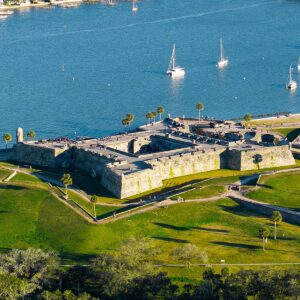
What To See at Castillo de San Marcos National Monument
The Castillo de San Marcos National Monument offers an immersive journey into St. Augustine’s complex history, including captivating St. Augustine landmarks. From its mighty stone walls to its impressive artillery, every feature of the fort tells a story.
Engage With Park Rangers
One of the major highlights of a visit is the informative talks presented by park rangers who share their comprehensive knowledge of the fort’s culture and history throughout the day. You can gain detailed insight into this St. Augustine historic site’s strategic importance, the lifestyle of its inhabitants, and its role in various conflicts.
Historic Weapon Demonstrations
For history buffs interested in military technology, the fort offers weapon demonstrations that showcase the operation of antique artillery, such as muskets and cannons. This hands-on demonstration provides a vivid picture of the warfare tactics employed during the fort’s active duty years.
Instagram-Worthy Photo Spots
The Castillo de San Marcos National Monument is not just an architectural marvel but also a splendid spot for relaxation. The lush green area within the fort’s property offers a serene setting for a picnic. Here, you can enjoy a meal amid nature with a stunning backdrop of the fort and sweeping views of the Matanzas Bay. Bring a camera along to capture the picturesque surroundings and the historic fort in all its glory.
As you wander around the fort, be sure not to miss the gun deck with its formidable cannons, the watchtower offering panoramic views, and the soldiers’ quarters that paint a picture of life in the fort. Each corner of the Castillo de San Marcos National Monument unravels a fascinating chapter of history, promising an unforgettable visit to this iconic St. Augustine landmark.
Flagler College History
Founded in 1968, the college is nestled within 19 acres of captivating landscapes, with the historic Ponce de León Hotel at its core. This iconic masterpiece was a feat of luxury and refinement, the brainchild of the legendary industrialist, oil magnate, and railroad pioneer, Henry Morrison Flagler. The hotel was designed by renowned architects John Carrere and Thomas Hastings, who successfully encapsulated Flagler’s vision of grandeur and elegance. Today, this St. Augustine historic site stands as a National Historic Landmark, the highest designation it could achieve, a fitting tribute to its historical and architectural significance.
Flagler College attracts students from across the globe to study liberal and fine arts against the backdrop of St. Augustine’s history. The college is host to an active community of approximately 2,500 students, whose presence adds to the liveliness and cultural wealth of the city.
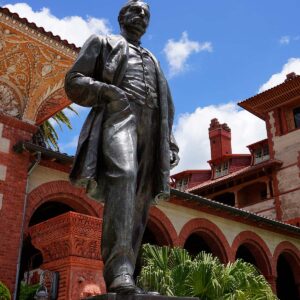
For visitors, the institution provides a window into the city’s illustrious past, with the opulence of the Ponce de León Hotel offering a stark contrast to the humble Spanish Colonial architecture that characterizes much of the city. The striking architecture, esteemed academic reputation, and profound historical significance of Flagler College establish it as an iconic landmark in St. Augustine.
What To See at Flagler College
Immerse Yourself in the Grandeur of the Ponce de León Hotel
This St. Augustine historic site, which once stood on an orange grove, epitomizes the European elegance that marked Flagler’s vision of St. Augustine as the American Riviera. The Spanish Revival-style building, embellished with Moorish Revival design elements, was the brainchild of celebrated architects John Carrere and Thomas Hastings.
Upon entering the former Ponce de León Hotel at Flagler College, the breathtaking rotunda greets visitors with its 68-foot domed ceiling, featuring an allegorical painting by George W. Maynard. The grand parlor, now known as the Flagler Room, features gilded coffered ceilings and onyx Thomas Edison clocks, capturing the extravagant lifestyle of the Gilded Age. The 79 Tiffany stained glass windows, the largest private collection in the world, emit a mesmerizing play of light.
Discover Art at the Crisp-Ellert Art Museum
The Crisp-Ellert Art Museum is an integral part of Flagler College, paying tribute to contemporary artistry and providing a unique contrast to the historical sites in St. Augustine. The museum’s art collections cover a diverse array of styles, mediums, and themes, adding a modern artistic dimension to the historical backdrop of the city. A stroll through the gallery will introduce you to compelling installations, captivating sculptures, lively paintings, and exquisite ceramics, offering a delightful break from exploring the traditional historical landmarks. The museum frequently hosts artist talks, workshops, and screenings, offering an interactive experience that extends beyond mere observation.
Key Highlights of Your Visit to Flagler College
During your visit, be sure to explore the beautifully landscaped grounds, dotted with palm trees and offering stunning views of the Spanish Renaissance architecture. Don’t miss out on the Legacy Tour, a guided walk led by student volunteers that takes you through the history-laden halls and rooms. The tour culminates in the Flagler College Solarium, where you can enjoy panoramic views of St. Augustine. Whether you’re an art enthusiast, a history buff, or someone who appreciates architectural beauty, Flagler College ensures a captivating visit filled with discovery and exploration.
History of Memorial Presbyterian Church in St. Augustine
In the midst of the opulence and grandeur that define St. Augustine’s historic sites stands another testament to Henry Flagler’s architectural legacy: the Flagler Memorial Presbyterian Church. Constructed in 1889, this church represents not just a religious institution but a deeply personal project for Flagler. It was constructed as a tribute to his cherished daughter, Jenny, who contributed a heartfelt story to the city’s extensive and varied history.
The Presbyterian congregation in St. Augustine has roots tracing back to June 1824 during Florida’s territorial period. Over the course of its history, the church building has played versatile roles within the community. It even served military purposes for the Union Army during the Civil War when regular services were temporarily suspended. In 1866, a home was purchased at the intersection of Hypolita and St. George Streets as a residence for the minister and his family, further cementing the church’s place in the local community.
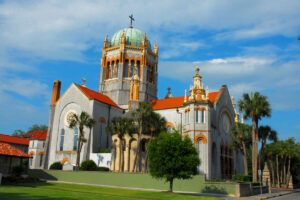
What To See at Memorial Presbyterian Church
The interior of Memorial Presbyterian Church is as breathtaking as its exterior, a testament to the enduring legacy of Henry Flagler and his penchant for intricate details.
The church’s hand-carved wooden pulpit, organ loft, and pews were crafted from Santo Domingo mahogany, offering an exquisite display of craftsmanship. The walls of the church are adorned with murals depicting biblical scenes, while the stained-glass windows cast a serene multicolored glow throughout the sanctuary. One of the most striking features of the church is the massive dome, inspired by St. Mark’s in Venice and covered in copper with a cross at the top. The dome’s interior boasts an elaborate fresco, and the church’s impressive organ, with its numerous pipes reaching skyward, is an architectural marvel in its own right. The memorial chapel, where Flagler and his family are entombed, is a poignant area of quiet reflection.
Touring Memorial Presbyterian Church
Guided tours of Memorial Presbyterian Church are available daily, providing a deeper appreciation of the church’s architectural grandeur and historical significance. They allow guests to wander through the church’s beautifully preserved interior, explore the tranquil grounds, and learn about the church’s history from knowledgeable guides. While on the tour, be sure to visit the Flagler family memorial area, which houses the mausoleum of Henry Flagler, his first wife Mary, their daughter Jenny, and her daughter Marjorie. This is a touching tribute to the family’s significant role in shaping St. Augustine’s history.
Another noteworthy attraction is the room that houses the original bell, which was installed when the church was constructed and continues to chime to this day. It’s a tangible connection to the church’s past, echoing the years of worship, fellowship, and community that have taken place within these walls.
Cathedral Basilica History
This St. Augustine landmark carries a profound historical tale dating back to its establishment in 1565. As the oldest Christian congregation in the contiguous United States, it stands as a timeless testament to the city’s deep spiritual heritage that spans over four remarkable centuries. Prepare to be captivated by the awe-inspiring legacy that resonates within these hallowed walls.
The construction of the Cathedral Basilica took place between 1793 and 1797, an ambitious project that saw the merging of the Spanish Mission and Neoclassical architectural styles, resulting in a unique aesthetic that has come to symbolize the city’s diverse cultural influences.
In 1970, the Cathedral Basilica was designated a U.S. National Historic Landmark, acknowledging its cultural and historical significance. Visitors are captivated by its architectural grandeur and its embodiment of the city’s Christian heritage.
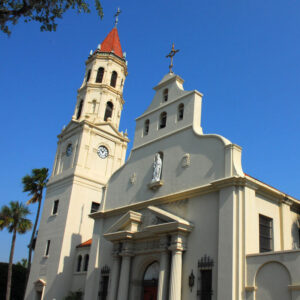
In 1997, the Cathedral Basilica was honored by Pope John Paul II with the status of a Cathedral Basilica. As a symbol of this recognition, the tintinnabulum (bell) and ombrellino (umbrella) now flank the High Altar, representing the Basilica’s esteemed position in the church hierarchy.
What To See at the Cathedral Basilica
Touring the Cathedral Basilica: A Journey of Discovery
During your visit to the venerable Cathedral Basilica of historic St. Augustine, ensure you immerse yourself in its divine array of spiritual and artistic offerings. The cathedral welcomes guests to behold the majesty of its deep red ceiling with glistening gold-leaf linden-wood statues, the harmonious sounds from the custom-built pipe organ, and the vivid murals depicting the impactful stories of missionaries, Native Americans, and Minorcans. The stained-glass windows, illuminating the life of Saint Augustine of Hippo, captivate all who gaze upon them. Daily tours are available for those eager to delve deeper into the cathedral’s sacred heritage, and for reflection, candles can be lit in memory of loved ones. Embrace the spirit of historic St. Augustine at Friday Art Walk Concerts or during a serene morning Mass, held at 7 a.m. on weekdays.
Fort Matanzas History
More than just stone and mortar, Fort Matanzas is an enduring symbol of the early Spanish empire’s might in historic St. Augustine. Nestled 15 miles north of St. Augustine, this fortification was constructed between 1740 and 1742 with coquina, a local shellstone. Its role in history was a decisive one, its ramparts standing as silent witnesses to the age-old conflicts of European powers vying for land and dominance in the New World. The fort’s sturdy walls, officers’ quarters, original cannons, and gunpowder room remain preserved, a testament to the engineering prowess of those bygone days. These fortifications are more than just historical artifacts; they’re tangible reminders of our shared past, whispering tales of courage, conflict, and conquest. Visiting Fort Matanzas National Monument is an essential experience for any history enthusiast vacationing in St. Augustine. It offers a fascinating lens into a pivotal era, allowing you to walk in the footsteps of the Spanish soldiers who once guarded this outpost. With every corner you explore, a new chapter of history comes to life, offering a distinct viewpoint of St. Augustine’s fascinating historical narrative.
What To See at Fort Matanzas
Visiting the Park
Nestled on the Intracoastal side of A1A, Fort Matanzas is a lush sanctuary of live oaks, native plants, and chirping birds, all enjoying the cool breeze of the water. Here, you can explore nature trails, unwind in picnic areas, or admire the wildlife and mangroves along the small stretch of beach.
Visitor Center
The visitor center offers a gateway to adventure, granting free boarding passes for a ferry ride to the fort itself. Near the visitor center, a picturesque picnic spot awaits, shaded by a mature oak canopy, complete with a public restroom facility and the trailhead for the Marsh Trail. This sandy path, less than a mile long, winds through the park’s natural marshland, a purifying system that shelters a multitude of park creatures and offers fantastic bird-watching opportunities.
Enjoy the Beach
Enjoy a serene moment at the beach, where the Matanzas River meets the Atlantic, offering one of St. Augustine’s most scenic views. Every step at Fort Matanzas is a journey through history, natural beauty, and pure tranquility.
History of the Old Jail Museum
The Old Jail Museum, backed by Henry Flagler and established in 1891, goes beyond a mere landmark; it represents a significant era in St. Augustine’s fascinating and eventful history. Until 1953, it served as the St. Johns County Jail, with its 27 cells and solitary confinement rooms narrating tales of convicts and courage. Landmarked on the National Register of Historic Places in 1987, the museum is particularly famous for hosting the Molly Maguire trials, resulting in the execution of seven Irish coal miners. Today, it stands as a fascinating capsule of Irish history and a compelling reminder of our past.
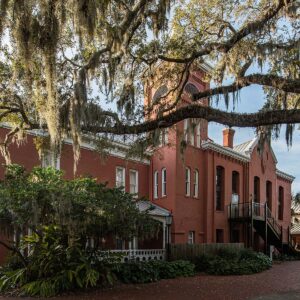
What to see at the Old Jail Museum
Explore the historical sites of St. Augustine through the immersive tours at the Old Jail Museum, where knowledgeable jailers guide you through prisoners’ cells, maximum security areas, gallows, and sheriff’s quarters. This unforgettable family-friendly journey offers a unique opportunity to experience the city’s intriguing history firsthand. The tours provide an intriguing look into the historical site in St. Augustine, allowing visitors to uncover the captivating stories that shaped the city, creating lasting memories for visitors of all ages. Plan your visit today and embark on an educational adventure through time.
One-Hour Tour of the Authentic Old Jail
Explore the haunting history of the Old Jail on a one-hour tour, delving into its eerie past. This unique experience offers a glimpse into the daily lives of the prisoners who once called it home. Traverse the atmospheric corridors and witness firsthand the conditions they endured. From the austere cells to the intriguing tales of escape attempts, this tour provides an immersive journey into the captivating history of the Old Jail. Step back in time and discover the stories that echo through its walls, making for an unforgettable exploration of the authentic and evocative past.
2.5-hour Old Jail After-Dark Paranormal Tour
The 2.5-hour Old Jail After-Dark Paranormal Tour offers a spine-chilling adventure through the jail after dark, with knowledgeable experts guiding visitors to explore the mysteries and witness potential supernatural activity. This immersive experience provides an unforgettable journey into the haunted building, allowing participants to engage in an actual paranormal investigation. With the use of the latest ghost-hunting equipment and expert guidance, guests can delve into the darker side of the Old Jail, ensuring a comprehensive and thrilling experience for all.
Conclusion
Leaving echoes of the past, St. Augustine’s landmarks allure us with timeless charm. From Fort Matanzas to the Old Jail Museum, these sites embody our shared history, captivating with narratives that resonate. A visit here is a journey through time, inviting reflection, learning, and appreciation. Until next time, St. Augustine!
FAQs
What is the most historically important building in St. Augustine?
- The Castillo de San Marcos
- Flagler College
- Lightner Museum
- St. Augustine Lighthouse & Maritime Museum
- The Cathedral Basilica
What is the oldest thing in St. Augustine?
Discover St. Augustine’s oldest resident, the “Old Senator” live oak tree. Estimated to be over 600 years old, it proudly stands in Villa 1565 on San Marco, embodying the enduring spirit of the city. Don’t miss this grand old tree, just a short hop from downtown!
What is the main historic street in St. Augustine?
St. George Street acts as the pulsating center of Downtown St. Augustine. Brimming with a multitude of shops, restaurants, art galleries, and attractions, this historically significant street stands as an indispensable destination in the Nation’s Oldest City. It’s a lively hub, teeming with the city’s fascinating history and culture. From local artisans to culinary delights, St. George Street is a treasure trove of experiences waiting to be discovered.
What is Flagler College known for?
Flagler College in Northeast Florida is known for its stunning architecture and exceptional education. Situated in the culturally rich and historic city of St. Augustine, it offers an academically challenging, inclusive, and supportive community, gaining national recognition for its unique programs.
